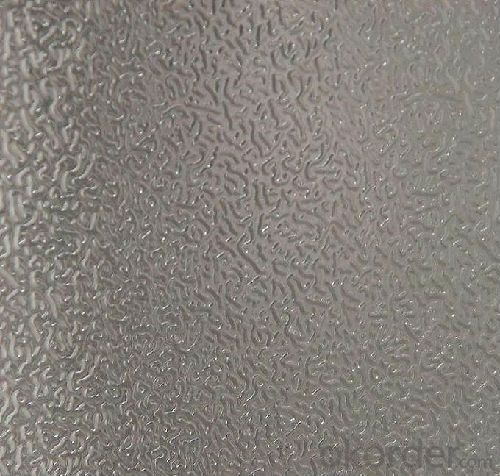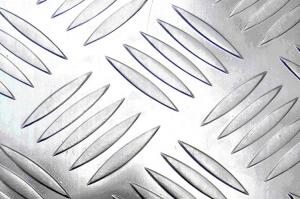AA5052 Five Bars Embossed Aluminum Roofing Sheets Ottawa
- Loading Port:
- Shanghai
- Payment Terms:
- TT or LC
- Min Order Qty:
- 5 m.t.
- Supply Capability:
- 9000 m.t./month
OKorder Service Pledge
OKorder Financial Service
You Might Also Like
Aluminium is a relatively soft, durable, lightweight, ductile and malleablemetal with appearance ranging from silvery to dull gray, depending on the surface roughness. It is nonmagnetic and does not easily ignite. A fresh film of aluminium serves as a good reflector (approximately 92%) of visible light and an excellent reflector (as much as 98%) of medium and far infrared radiation. The yield strength of pure aluminium is 7–11 MPa, while aluminium alloys have yield strengths ranging from 200 MPa to 600 MPa. Aluminium has about one-third the density and stiffness of steel. It is easily machined, cast, drawn and extruded.

Product details:
Alloy No.: 5052
Type | Aluminum embossed plate |
Alloy Type | 5052 |
Temper | O,H14,H16,H18,H22,H24,H26,H28,H32,H34,H36,H38, H112,F,H111 |
Shape | 5 bar, stucco embossed, diamond |
Ridge height | 0.8-1.2mm |
Ridge Length | 38mm |
Thickness | 1.0 -8.0 mm |
Width | Under1900mm |
Length | Under12000mm |
Adopted Standard | GB/T 3880-2006 ,EN485,ASTM B209 |

Surface:
Be flat and without bagginess across the web, free of dents,scraches and holes.
The edges of the sheet must be smooth and evenly would.
The Surface of sheet be lustre or frosted,without cracks,divisions into layers,holes and corrosion spots.
Application:
anodizing, oxidation for decoration, high-precision products and so on.

- Q: is aluminum foil spacer poisonous after heating?
- many baked food will use aluminum foil.
- Q: You are probably think wtf. Lol, so I just got a Mac and I HATE its keyboard! Also, I have been looking at Fallout 3, and I think its looks amazing! Here is my question: Should I get the new aluminum keyboard for my Mac or Fallout 3? I have $60 to spend and I have found a place to get one or the other for under $60. I could also get on Ebay and get BOTH! Which one/option should I do?
- Have you used the Apple Aluminum keyboard before? Most people either love it or hate it. The low-profile keys feel a lot different than a traditional keyboard. Personally, I like it and can type faster on the AL, but I know a lot of people that got rid of it and got a different keyboard. You don't NEED to use an Apple keyboard on your Mac - you can use any USB keyboard you want. So you COULD get a cheaper alternate keyboard and still get Fallout as well. Windows keyboards don't have the same quick pick button across the top as an Apple keyboard, but you can custom configure your keyboard commands in System Profile-Keyboard Mouse-Keyboard Shortcuts (under the Apple logo at the top-left of your screen) and set whatever keys or key combos to do those missing commands. But I don't think Fallout 3 is out for Mac, is it? I couldn't find a version with a quick Google search.........a Windows version won't run on your Mac unless you have Windows installed with either Boot Camp (included in OS X 10 Leopard) or with a virtual PC like VMWare Fusion or Parallels. Unless you are running Windows on your Mac (like I am) don't waste your money on a PC game you won't be able to play. Enjoy your new Mac!
- Q: Are 101 aluminum sheets suitable for cryo-treating applications?
- No, 101 aluminum sheets are not suitable for cryo-treating applications.
- Q: Can aluminum sheets be used for honeycomb panels?
- Indeed, honeycomb panels can indeed utilize aluminum sheets. To create honeycomb panels, it is customary to bond two slender sheets of material, like aluminum, to a core material in a honeycomb formation. Aluminum sheets are frequently employed in this process due to their advantageous traits of being lightweight and possessing high strength, rendering them an optimal selection for constructing honeycomb panels. The honeycomb structure itself results in a superior strength-to-weight ratio, rendering the panels suitable for an array of applications, encompassing aerospace, automotive, construction, and furniture industries. In addition to this, the aluminum sheets offer desirable attributes such as durability, resistance to corrosion, and ease of fabrication, thereby making them a widely favored option for honeycomb panels.
- Q: When water continually sprays on the aluminum sheet, how to avoid corrosion of aluminum sheet and keep its water resistance?
- aluminum will react with oxygen, generating dense Al2O3 oxide film on the surface, once the pure aluminum is exposed in air, it will react with air, generating oxide film to protect it.
- Q: What is the thermal expansion coefficient of aluminum sheets?
- The thermal expansion coefficient for aluminum sheets measures around 23.1 x 10^-6 per degree Celsius, resulting in a length expansion of 23.1 parts per million for every one-degree Celsius temperature rise. Nevertheless, it's worth noting that this coefficient might slightly differ depending on the exact alloy and manufacturing technique employed in the production of the aluminum sheet.
- Q: How do aluminum sheets perform in terms of impact resistance?
- Aluminum sheets are known for their excellent impact resistance properties. Due to their high strength-to-weight ratio, they can withstand significant impacts without deforming or breaking easily. Additionally, aluminum has inherent toughness and flexibility, which allows it to absorb and distribute the force of an impact, minimizing the risk of damage. This makes aluminum sheets a preferred choice for applications requiring durability and resistance to impact, such as in the automotive, aerospace, and construction industries.
- Q: How do aluminum sheets perform in terms of creep resistance?
- Aluminum sheets generally exhibit good creep resistance, especially when compared to other metals. Aluminum has a low melting point and high thermal conductivity, which helps in reducing creep deformation. It also has a fine-grained microstructure that enhances its resistance to creep. However, it is important to note that the creep resistance of aluminum sheets can be affected by factors such as temperature, load, and alloy composition.
- Q: Are 101 aluminum sheets suitable for agricultural machinery?
- Yes, 101 aluminum sheets are suitable for agricultural machinery. Aluminum is a versatile and lightweight material that offers several benefits for agricultural machinery. It has excellent corrosion resistance, which is crucial for equipment exposed to various weather conditions and chemicals commonly found in the agricultural industry. The strength-to-weight ratio of aluminum is also advantageous, allowing for increased payload capacity and fuel efficiency. Additionally, aluminum is easily formable, enabling manufacturers to create complex shapes and designs for machinery components. Overall, 101 aluminum sheets provide the durability, corrosion resistance, and versatility required for agricultural machinery.
- Q: have been taking an over the counter Antacid consistently for the past 8 years as a daily source of extra calcium per the bottle. Now, I am getting many nerve problems, similar to Lou Gehrig's disease. I am a healthy 38 year old male who excersises, eats right and is generally health conscious. I am concerned that unknowingly I have toxified my body with the aluminum that apparently is in Antacid. I did not know this until now or of course I would not have gone any where near it.Can taking Antacid lead to nerve problems such as Lou Gehrig's disease?
- Aluminum okorder /
Send your message to us
AA5052 Five Bars Embossed Aluminum Roofing Sheets Ottawa
- Loading Port:
- Shanghai
- Payment Terms:
- TT or LC
- Min Order Qty:
- 5 m.t.
- Supply Capability:
- 9000 m.t./month
OKorder Service Pledge
OKorder Financial Service
Similar products
Hot products
Hot Searches
Related keywords




























